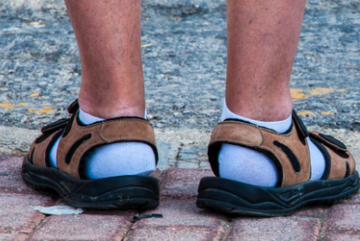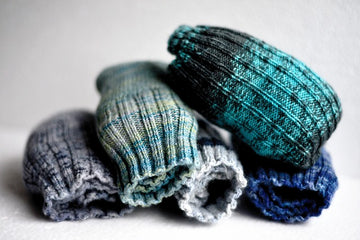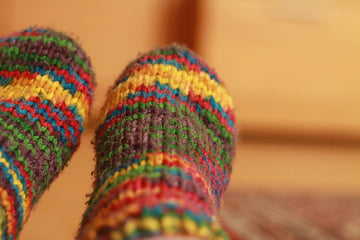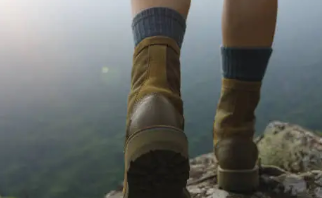
Socks have a surprisingly long and fascinating history. From their humble beginnings as foot coverings in ancient times to the colorful and diverse styles we know today, socks have come a long way. This article delves into the intriguing story of socks, exploring their evolution, cultural significance, and the rise of the ankle socks.
When Were Ankle Socks Invented
Fashion, like history, is a constant dance of evolution. As clothing styles shifted, so too did footwear, giving rise to a diverse range of sock designs. Amongst these, the humble ankle sock holds a unique place. Unlike its taller cousins, the ankle sock graces only the ankle and lower calf, offering a touch of practicality with a hint of panache.
The exact origin of the ankle sock remains shrouded in mystery, but its rise to fame undeniably occurred in the early 20th century. Athletes, particularly tennis and golf players, embraced the ankle sock for its functionality. The shorter design provided essential support while keeping feet cool and comfortable during intense activity. As sports culture flourished, so did the demand for practical yet stylish sportswear, propelling the ankle sock into the global spotlight.
But fashion, as always, is cyclical. The roaring twenties, a decade synonymous with societal upheaval and sartorial experimentation, witnessed a fascinating shift. Ankle socks transcended their athletic origins, becoming a coveted accessory for women. Shorter hemlines, a hallmark of the era, brought the hidden sock into the light, transforming it into a statement piece. Suddenly, ankle socks were a fashionable choice for both formal and casual wear.
Furthermore, iconic figures like the trailblazing dancer Josephine Baker and the captivating actress Clara Bow further cemented the ankle sock's status symbol. In their hands, the sock became more than just foot protection; it embodied youth, a spirit of liberation, and a willingness to embrace daring fashion choices. The ankle sock, once a humble athlete's companion, had become a symbol of a changing world and a woman's newfound freedom.
When Were No-Show Socks Invented
The no show socks, which became widely popular around the year 2000, are designed to be hidden when worn with shoes, offering a sockless appearance while still providing the comfort and hygiene of wearing socks. Before the advent of these socks, the closest alternative were the ankle socks with pompoms that gained popularity in the 1970s. Many people indeed opted to go sockless with certain types of shoes before "no show" socks became available, especially when aiming for a specific style or look.
When Were Socks Invented
The exact invention of socks is a bit fuzzy, but there's evidence of people wearing foot coverings as far back as the Stone Age! These early versions were probably more like sandals than socks, made from plant materials.
The first knitted socks we've found come from ancient Egypt, around 300-500 AD. These were made with a technique called nålbinding, and they even had separate toes for each foot!
Who Invented Socks and Sandals
The Romans get the credit, or at least the historical documentation, for rocking the socks-and-sandals combo. Evidence suggests they were doing it as far back as 2,000 years ago!
Interestingly, the oldest known socks (from Egypt) were also designed to be worn with sandals. So it seems this practical and, some might say, questionable, fashion choice has been around for a very long time.
History of Socks Timeline
Socks have a long and interesting history, evolving from humble beginnings to the colorful and comfy companions we know today. Here's a whistle-stop tour through time:
- Ancient Times (8th Century BC): The earliest evidence of sock-like foot coverings comes from Greece. People wrapped their feet in leather or "piloi," made from matted animal hair.
- Roman Empire (2nd Century AD): The Romans take things a step further, sewing pieces of fabric together to create fitted socks called "udones".
- Medieval Europe (5th-15th Century AD): Socks become a symbol of wealth and status among the nobility. They're often made from luxurious materials like silk and wool, and some folks even sport mismatched pairs to show off!
- 16th Century: The invention of the knitting machine in 1589 is a game-changer. Now socks can be produced much faster, making them more accessible.
- Industrial Revolution (18th-19th Century): Mass production takes hold, and socks become widely available to the masses.
- 20th Century: New materials like nylon (invented in 1938) are introduced, offering more durability and variety in sock construction.
- Modern Day: Socks come in a dizzying array of styles, materials, and lengths, from the humble ankle sock to the fashionable knee-high. They're no longer just practical; they're a way to express yourself!
This is a simplified timeline, but it gives you a taste of the long journey socks have taken. From protecting feet to becoming a fun fashion statement, socks have truly stood the test of time.
Were Socks or Shoes Invented First
Shoes definitely came first! The evidence for shoes goes way back in history. The oldest leather shoes found by archaeologists date back to around 3500 BC! These were simple designs, likely for protection from the elements.
The earliest sock-like coverings are much younger. While there's evidence of people wrapping materials around their feet as far back as the Stone Age, true socks (like knitted ones from Egypt) appear around 300-500 AD.
When Were Ankle Socks Popular?
Ankle socks have actually been popular throughout various points in history, though for different reasons:
- 1920s: The rise of shorter hemlines for women's clothing made ankle socks a more visible and stylish choice.
- 1950s: Ankle socks, particularly bobby socks for women, were a big trend, especially among teenagers.
- 1970s: While crew socks were popular, ankle socks remained a casual option for sneakers.
- 1990s: Minimalism and athletic wear became prominent, bringing ankle socks back into style, often with logos and branding.
Even today, ankle socks remain a popular choice for both men and women, due to their comfort and versatility with various footwear.
What Was Worn Before Socks?
Before socks, people used various coverings for their feet, primarily made of natural materials.
- Footwraps: These were the most common alternative. People would wrap strips of cloth around their feet and ankles for warmth and protection. This method was used in many cultures around the world and remained popular even after socks became available, especially by soldiers until recently.
- Animal Skins/Pelts: In colder climates, people might use animal skins or pelts cut to size and tied around their feet for extra warmth and insulation.
- Plant Materials: In some cultures, people might have used readily available plant materials like leaves or bark to create a rudimentary foot covering.
These methods wouldn't have provided the same level of fit and comfort as modern socks, but they served a similar purpose of protecting feet.
Who Invented Ankle Socks?
Thousands of years ago, in places like ancient Greece and Northern Europe, people wrapped animal skins around their feet to keep warm. While the exact inventor of ankle socks remains unknown, the Egyptians were among the first to develop rudimentary foot coverings that paved the way for later sock designs.
What Is the Oldest Pair of Socks?
Archaeologists discovered a pair of woolen wonders in Egypt! These champion title holders for oldest socks hail from the 4th century and were found in the ancient city of Oxyrhynchus. Interestingly, these red socks were designed for two toes each, possibly meant to be companions for sandals, a common footwear choice back then.







